<span style="font-weight: bold">Opening the box:</span>
• Attractive looking box and packaging.
• The package includes the following
1. Vortex Razor HD
2. Sunshade.
3. Rings. (I believe the scope can be ordered with, or without Vortex 35mm rings.
4. Allen wrench to loosen windage and elevation knobs.
5. ARD.
6. Instruction booklet is well thought out.
7. Caps for objective and ocular lens were horrible.
With an MSRP of 2500.00, the caps should have been Butler Creeks. The caps that came with the scope had a cheap look and feel to them. They also did not stay in position during recoil. I would get a quick flash of black each time I fired due to the front objective cap flopping down under recoil. Everyone I showed the scope to had the same feelings about the caps.
<span style="font-weight: bold">Physical Appearance of the Optic:</span>
• Dark earth anodizing is awesome. It’s refreshing to see an optic that is just not plain black.
• The 50mm front objective is very nice. The Razor looks beefy, yet felt compact mounted on a full size rifle.
• Elevation Knob is a little big for my taste.
• Windage knob is fine.
• The parallax knob is a little too small. This is the one knob that a shooter constantly adjusts to focus at different ranges or on different targets.
• Fiber optic piece on top of the elevation knob popped off even before I got the scope out to the range. I think it popped off while I was spinning the elevation knob at home... It’s a neat feature, but not truly needed in my opinion.
• Overall the Vortex Razor is a very attractive looking scope.
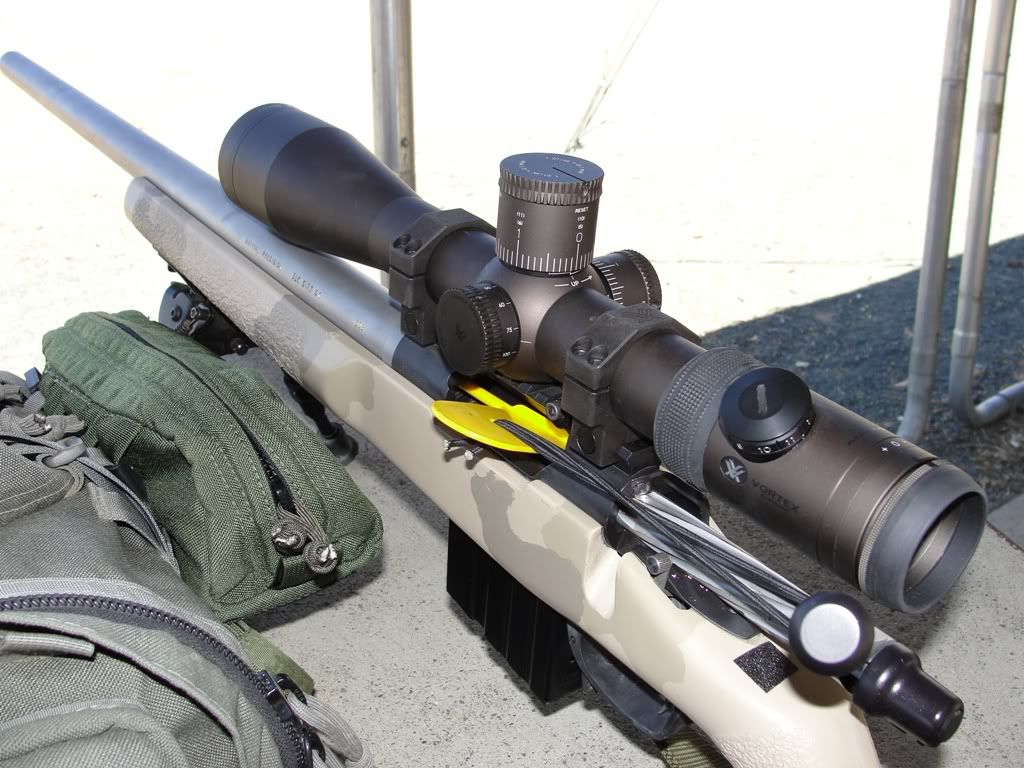
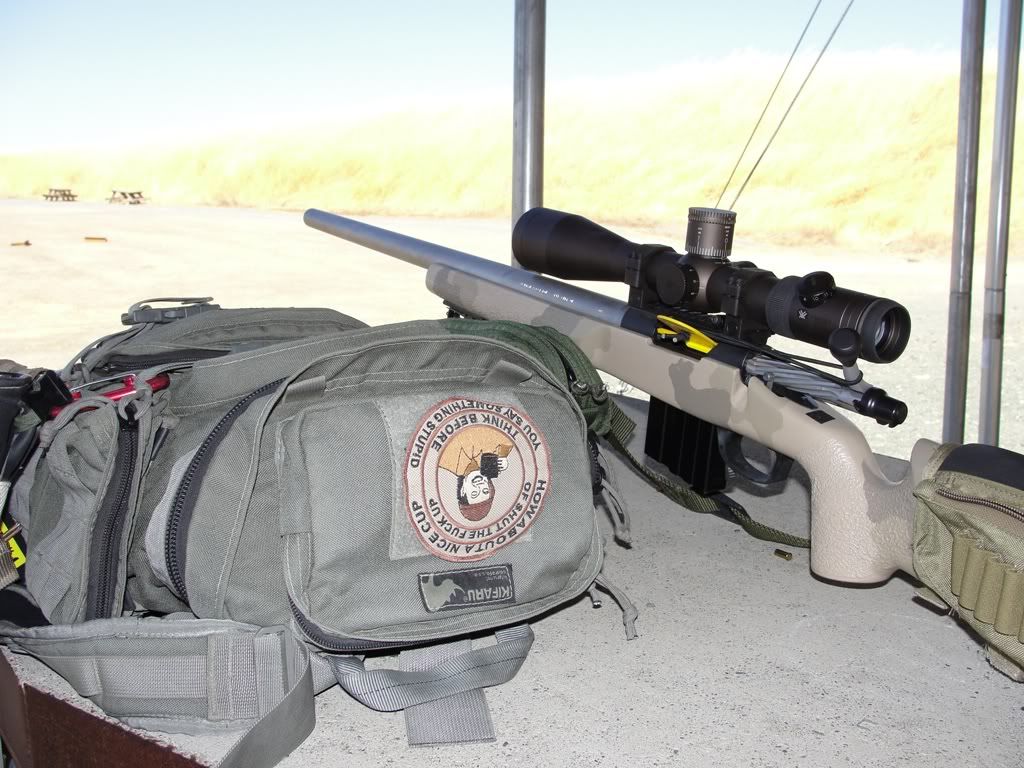
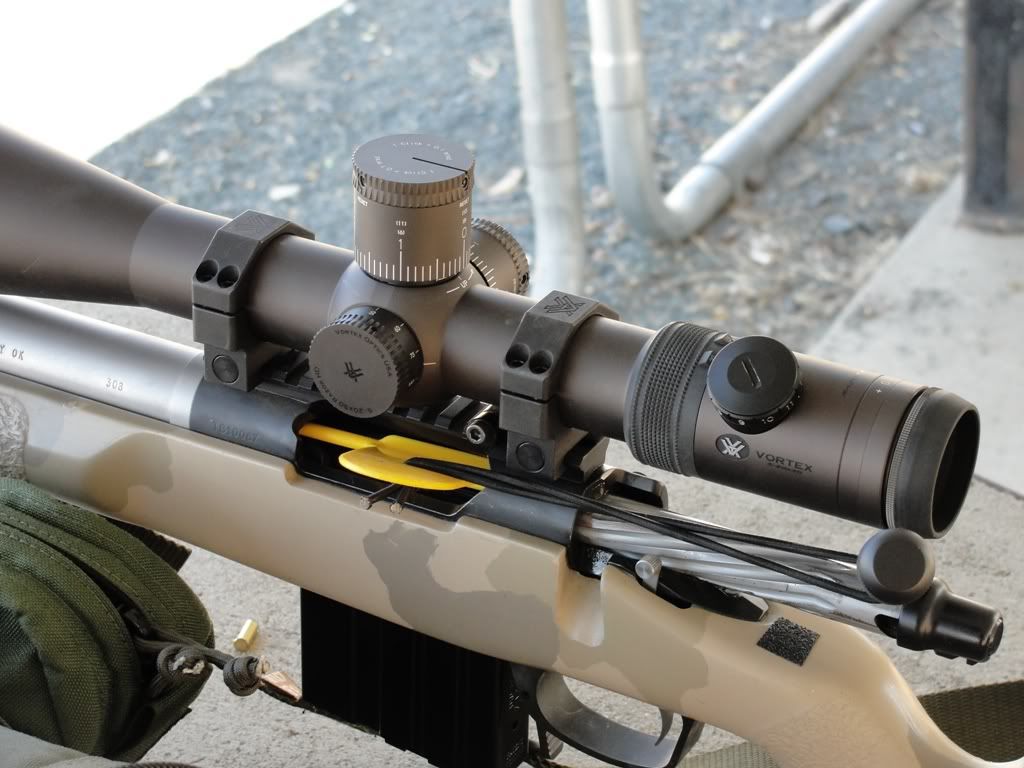
<span style="font-weight: bold">Vortex 35mm Rings</span>
• The fit and finish of the rings were nice and solid.
• The only complaint is the Allen screws vs. torx. Everything else on my rifle is torx so I don’t carry a set of Allen wrenches in my kit. Luckily Vortex provided the necessary tool.
<span style="font-weight: bold">EBR-3 Reticle:</span>
• At first glance, I thought it was a lil too thick for my taste. However, after a lil bit of range time I found punching out 1” dots @ 100yards is very doable. Most competition shooters like a reticle where they can quarter a 1” dot at 100yards.
• The EBR-3 is simple and very functional. It is not busy whatsoever and has everything that is needed by a shooter.
• I like the fact that I can hold up to 8mils and hold under up to 4 mils on EBR-3.
• We had the EBR-2 on our first sample that was sent back for a canted reticle. Personally I like the concept of the EBR-2 with the hold points for windage and elevation. However, I found the hold points too fine for use less than 12X. A lot of times it would wash out while looking at a darker target. It also had way too many dots. I primarily shoot a Gen II XR reticle from Premier and like the wind hold values of 1/2mil and 1 mil. Too many hold points just confuses people I believe. When a competitor or shooter is using his hold over, he wants speed over precision.
• The more I used the EBR-3, the more I liked it.
Controls (Windage, Elevation, and Parallax)
• The elevation and windage adjustments were nice, but I would have preferred a more positive engagement of the clicks. During one of matches I shot with the Razor, the windage knob got caught on some of my kit and it applied enough pressure to turn it .6 mils. Luckily I caught this during my pre-shot check list. I know for a fact that the knob turned during slung transport because I hold for wind and rarely dial.
• I think the size of the windage turret is perfect. It would be nice to see the elevation and parallax turrets match in size.
• While it is nice to have big chunky clicks, I would prefer a 10 mil per revolution elevation and windage turret. 10 mils per turn up or down, 5 mils right, 5 mils left. Most shooters will be able to dial out to 1000 yards in one revolution.
A lot of shooters commented on how easy it would be to get lost on the windage knob with it only going to 2.5mils and then having the numbers go backwards. In my opinion the Premier Heritage windage system is the best on the market. 5 mils left and right, with zero stops. It is dummy proof as can be.
<span style="font-weight: bold">Zeroing the Optic</span>
• The smooth turn knob was little different from what I am use to and I had some issues while zeroing the rifle the first time. During the zeroing process I felt like I would either over shoot or under shoot what I was seeing in the scope. It took a little bit of getting use to, but after zeroing the scope once or twice, the smooth turn knob is actually a nice feature to have. Instead of being stuck with .1 mil adjustment during zeroing, you just turn in .05 mil to have a dead nuts zero if needed. Once you lock down the turret, it would go to .1mil adjustments at each click.
<span style="font-weight: bold">Track Testing</span>
I use an American Precision Arms custom built .22 to track test a lot of our scopes out here. This rifle will stack 5 rounds into 1 hole at 50 meters all day long. I run this test to ensure that what I dial matches what I see through the scope using the reticle. I fired 3 to 4 rounds at each adjustment. It was a windy day for a .22 so my groups did open up a little.
The target is a grid with 5 centimeter boxes, and was set at 50 meters. At this distance the round should land right at 5 centimeters per 1.0 mil come up. I should also see the reticle match up with the impacts as well.
I ran the scope up to 10mils and left/right 2mils.
As you can see in figure 1 below, everything tracked fairly well. However, I did notice that my impacts would land .1mil to .2mils high as I came up in elevation.
I would also see this same result as I shot the rifle at distance. My come ups with the Vortex mounted was exactly .1. to .2mils less than when I shot the same rifle and load with my Premier 5-25X. At 1000 yards I normally run 9.8mils and with the Vortex I was 9.6mils. I notice this trend when moving past 500 yards. Inside this distance, it was not noticeable.
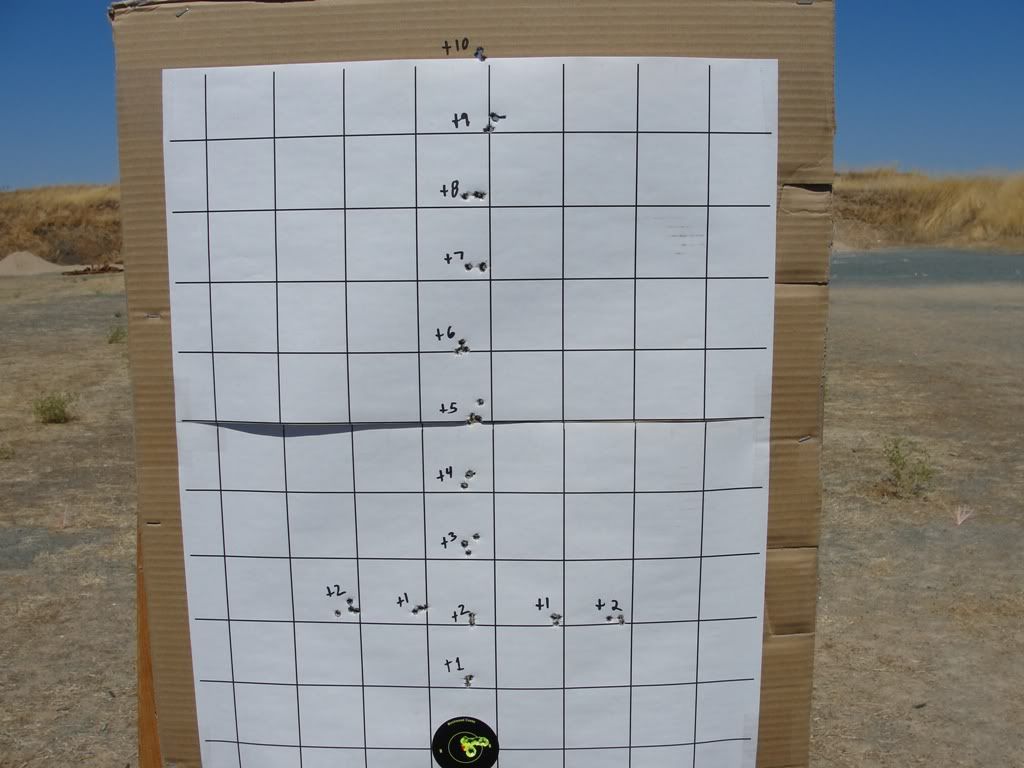
<span style="font-weight: bold">Holding Zero Testing</span>
For this test, since I did not want to destroy the optic so I just did a simple impact test. I took the scope off at home and continued to beat it on a telephone book with a fair amount of force. I probably gave it around 30 to 40 whacks. After this, I spun the knobs as hard and fast as I could until my hands got tired. I did this for about 3 nights in a row before my next range day with the optic.
I went back to the range, remounted the scope, zeroed the gun, and shot this group @ 100yards pictured below.
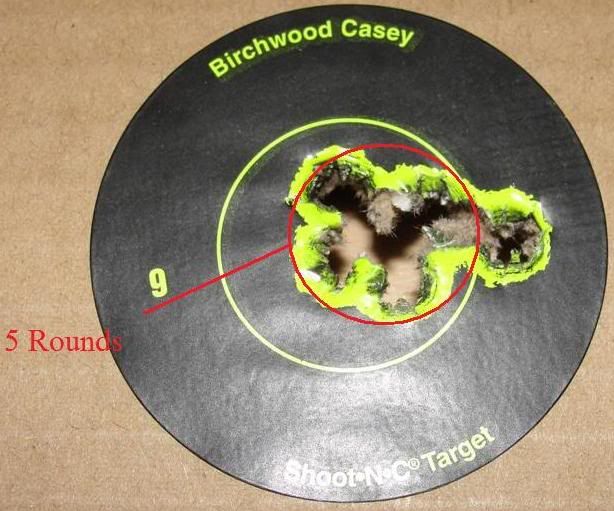
After the rifle was zeroed, I continue to spin the knobs some more and shot 3 more rounds to confirm the Vortex would hold its zero. I fired these rounds @ 100 yards. The inner circle of the Shoot N C is 1”. I pulled a shot on the 3rd round so I fired a 4th round to confirm.

Next I wanted to ensure the Vortex would have the same point of aim and impact on different magnifications. I shot from bottom to top. Started out at 10X and worked my way up to 20X. I also spun the knobs like crazy in between each shot. Winds were blowing pretty good by this time of day and I had a good 9 to 3 o’clock going. This was a used target so don’t mind the other holes. I had a buddy try to zero his hunting rifle on it. As you can tell, his hunting rig wasn't close to zero. LOL
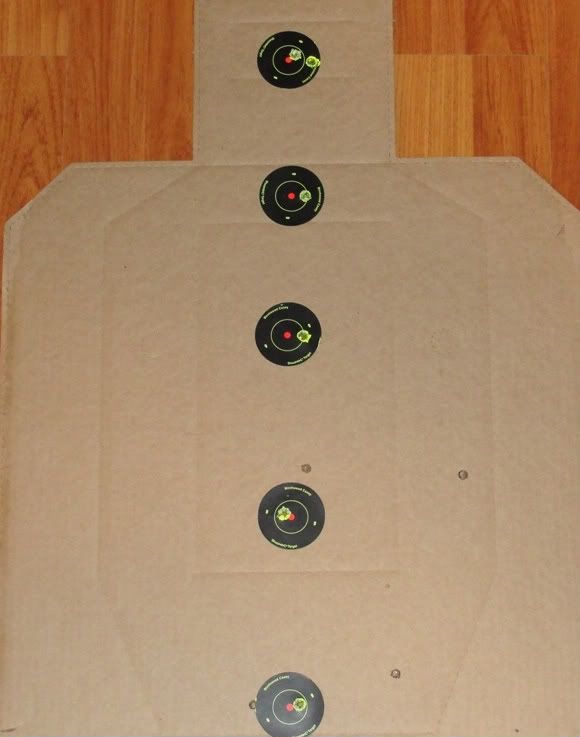
<span style="font-weight: bold">Quality of the Glass</span>
The Vortex Razor is right there with the NXS through about 16X, but when it was cranked up to 20X, I think the NXS has a slight edge. Personally I would rate the clarity of the glass about 1 point below Nightforce at the higher magnifications.
There were a few times in heavy mirage (90 + degree day) where I had a hard time finding my spotter on our targets @ 900 and 1000 yards.
I know several have commented on eye relief being a little finicky. Personally, I was able to get a good sight picture easily up to about 17X. At max magnification you just had to make sure you were lined up correctly to get a good sight picture. At lower magnification eye relief is pretty forgiving.
<span style="font-weight: bold">In the Field Testing</span>
I ended up shooting about 350 - 400 rounds with the Vortex Razor mounted on my Newman Precision 308win. I knew my Newman would perform and shoot well, now it was up to the Razor to track and hold zero.
Over the past several months I shot the following matches:
• (1) F-Class match, 300, 500, 600, and 800 yards.
• (2) NCPPRC Tac LR Matches
• (2) NCPPRC Precision Steel Match
• (2) NCPPRC LR Practice Sessions
• Multiple trips to the 100/200 bay to confirm zero and track testing.
After gathering dope out to 1K on paper with the Razor, I did notice a .1 and .2mil difference in my dope between my Premier 5-25X mounted on the same rifle, shooting the same load. Once I had my numbers, it was solid out to 1K each and every time.
Below is my 300yard target from the F-Class match. If you took out the 9 I dropped, it would be a 2.40” 14 shot group. I think the score was a 149 5X.

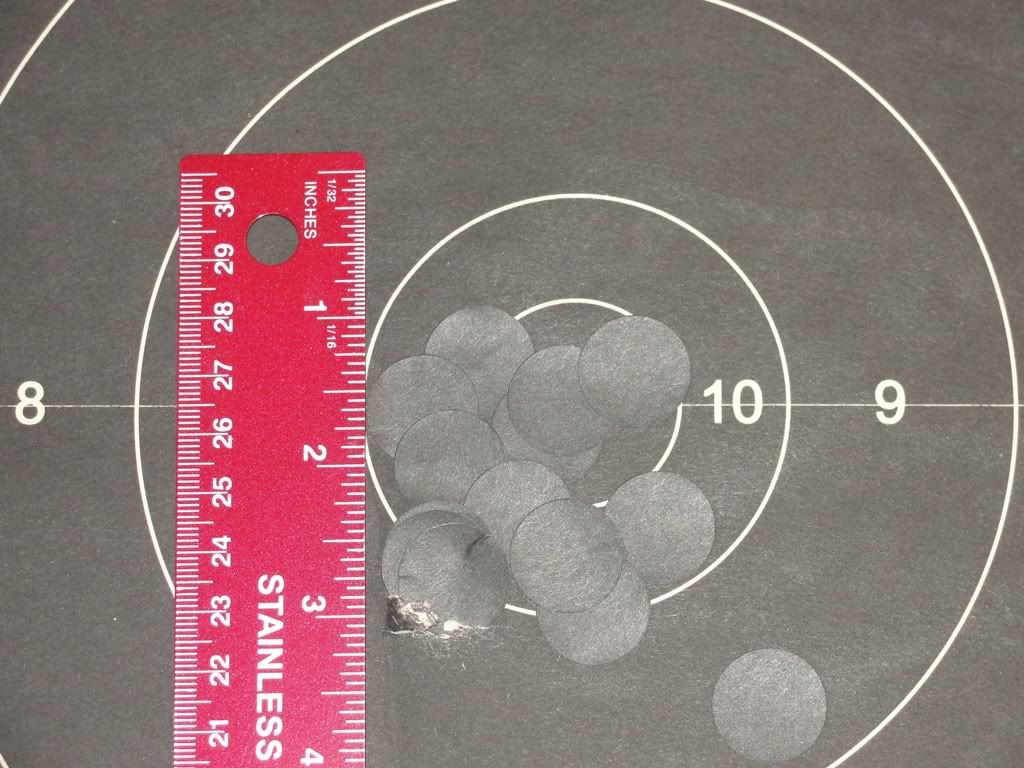
Throughout the other matches, the Razor held zero and rounds impacted where I dialed to. Once I had solid numbers, the scope repeated each and every time at distances from 100yards to 1K.
One of the steel matches was an all mover match and having a little thicker reticle was handy when dialing down to gain a wider FOV. I was able to dial down to 10X and still see where I was holding on the reticle.
<span style="font-weight: bold">Last Track Test</span>
I wanted to do one last track test to make sure everything still tracked the same. This target almost matches up perfectly with the original track test I did prior to mounting the Razor on my Newman Precision 308win.

<span style="font-weight: bold">Price Point and Value</span>
This portion of the evaluation is my own personal opinion and is based on what I have noticed over the years.
With an MSRP of $2500.00, and street sale price of $2000.00 to $2100.00 with rings, it will be a hard sell due to the all the other scopes in this price range with a proven track record. Most consumers that break the $2000.00 threshold will not mind shelling out 300.00 – 1000.00 more to get into a USO, Premier, Hensoldt, or S&B.
Serious shooters want battle/time proven optics. Most will hesitate to put a fairly new optic into play at a big event. However I think with some tweaks here and there, and a few years to allow the Razor to gain some “street credit”, I think the Razor could be one of the top optics in the market as it evolves over time.
That being said, the Razor is hard to beat for a shooter that needs FFP, 5-20X, Mil/Mil, or MOA/MOA, illumination, zero stop, rings, a reticle that is numbered and accessories for around $2000.00.
After all the rounds down range with the Razor, it has truly grown on me. I really didn’t want to send it back. I will have to add one to my stable when funds permit.
<span style="font-weight: bold">Overall</span>
In my opinion the Vortex Razor is a solid, viable option for the end users. It is completed loaded with features that cost a lot more in other brands. The other thing I would like to comment on is the customer service and personal dealings I have had with the folks at Vortex. The customer service and willingness to listen to the end user is outstanding.
They were very accommodating when I requested an EB3 vs. the EBR2. I had another test scope within 72 hours. The scope was sent to me during a very busy time this past summer and Vortex had no problems with me keeping the scope a little while longer to complete all the T&E.
Vortex is a fairly new player in the high end optics arena, but came out swinging hard with the Razor HD. I believe we are going to continue to see great things from Vortex in the future.
I would like to thank the folks at Vortex on behalf of the Nor Cal Practical Precision Rifle Club for allowing me to T&E the Vortex Razor. Hopefully the information I have provided in this T&E can help further the development of any future optic.
Test Rifle: Newman Precision 308win
175gn SMK @ 2740FPS
2.20" to Ogive.
44gn of Varget
FGMM Case
CCI BR2 Primers
Test Facility: Sac Valley Shooting Center
• Attractive looking box and packaging.
• The package includes the following
1. Vortex Razor HD
2. Sunshade.
3. Rings. (I believe the scope can be ordered with, or without Vortex 35mm rings.
4. Allen wrench to loosen windage and elevation knobs.
5. ARD.
6. Instruction booklet is well thought out.
7. Caps for objective and ocular lens were horrible.
With an MSRP of 2500.00, the caps should have been Butler Creeks. The caps that came with the scope had a cheap look and feel to them. They also did not stay in position during recoil. I would get a quick flash of black each time I fired due to the front objective cap flopping down under recoil. Everyone I showed the scope to had the same feelings about the caps.
<span style="font-weight: bold">Physical Appearance of the Optic:</span>
• Dark earth anodizing is awesome. It’s refreshing to see an optic that is just not plain black.
• The 50mm front objective is very nice. The Razor looks beefy, yet felt compact mounted on a full size rifle.
• Elevation Knob is a little big for my taste.
• Windage knob is fine.
• The parallax knob is a little too small. This is the one knob that a shooter constantly adjusts to focus at different ranges or on different targets.
• Fiber optic piece on top of the elevation knob popped off even before I got the scope out to the range. I think it popped off while I was spinning the elevation knob at home... It’s a neat feature, but not truly needed in my opinion.
• Overall the Vortex Razor is a very attractive looking scope.



<span style="font-weight: bold">Vortex 35mm Rings</span>
• The fit and finish of the rings were nice and solid.
• The only complaint is the Allen screws vs. torx. Everything else on my rifle is torx so I don’t carry a set of Allen wrenches in my kit. Luckily Vortex provided the necessary tool.
<span style="font-weight: bold">EBR-3 Reticle:</span>
• At first glance, I thought it was a lil too thick for my taste. However, after a lil bit of range time I found punching out 1” dots @ 100yards is very doable. Most competition shooters like a reticle where they can quarter a 1” dot at 100yards.
• The EBR-3 is simple and very functional. It is not busy whatsoever and has everything that is needed by a shooter.
• I like the fact that I can hold up to 8mils and hold under up to 4 mils on EBR-3.
• We had the EBR-2 on our first sample that was sent back for a canted reticle. Personally I like the concept of the EBR-2 with the hold points for windage and elevation. However, I found the hold points too fine for use less than 12X. A lot of times it would wash out while looking at a darker target. It also had way too many dots. I primarily shoot a Gen II XR reticle from Premier and like the wind hold values of 1/2mil and 1 mil. Too many hold points just confuses people I believe. When a competitor or shooter is using his hold over, he wants speed over precision.
• The more I used the EBR-3, the more I liked it.
Controls (Windage, Elevation, and Parallax)
• The elevation and windage adjustments were nice, but I would have preferred a more positive engagement of the clicks. During one of matches I shot with the Razor, the windage knob got caught on some of my kit and it applied enough pressure to turn it .6 mils. Luckily I caught this during my pre-shot check list. I know for a fact that the knob turned during slung transport because I hold for wind and rarely dial.
• I think the size of the windage turret is perfect. It would be nice to see the elevation and parallax turrets match in size.
• While it is nice to have big chunky clicks, I would prefer a 10 mil per revolution elevation and windage turret. 10 mils per turn up or down, 5 mils right, 5 mils left. Most shooters will be able to dial out to 1000 yards in one revolution.
A lot of shooters commented on how easy it would be to get lost on the windage knob with it only going to 2.5mils and then having the numbers go backwards. In my opinion the Premier Heritage windage system is the best on the market. 5 mils left and right, with zero stops. It is dummy proof as can be.
<span style="font-weight: bold">Zeroing the Optic</span>
• The smooth turn knob was little different from what I am use to and I had some issues while zeroing the rifle the first time. During the zeroing process I felt like I would either over shoot or under shoot what I was seeing in the scope. It took a little bit of getting use to, but after zeroing the scope once or twice, the smooth turn knob is actually a nice feature to have. Instead of being stuck with .1 mil adjustment during zeroing, you just turn in .05 mil to have a dead nuts zero if needed. Once you lock down the turret, it would go to .1mil adjustments at each click.
<span style="font-weight: bold">Track Testing</span>
I use an American Precision Arms custom built .22 to track test a lot of our scopes out here. This rifle will stack 5 rounds into 1 hole at 50 meters all day long. I run this test to ensure that what I dial matches what I see through the scope using the reticle. I fired 3 to 4 rounds at each adjustment. It was a windy day for a .22 so my groups did open up a little.
The target is a grid with 5 centimeter boxes, and was set at 50 meters. At this distance the round should land right at 5 centimeters per 1.0 mil come up. I should also see the reticle match up with the impacts as well.
I ran the scope up to 10mils and left/right 2mils.
As you can see in figure 1 below, everything tracked fairly well. However, I did notice that my impacts would land .1mil to .2mils high as I came up in elevation.
I would also see this same result as I shot the rifle at distance. My come ups with the Vortex mounted was exactly .1. to .2mils less than when I shot the same rifle and load with my Premier 5-25X. At 1000 yards I normally run 9.8mils and with the Vortex I was 9.6mils. I notice this trend when moving past 500 yards. Inside this distance, it was not noticeable.

<span style="font-weight: bold">Holding Zero Testing</span>
For this test, since I did not want to destroy the optic so I just did a simple impact test. I took the scope off at home and continued to beat it on a telephone book with a fair amount of force. I probably gave it around 30 to 40 whacks. After this, I spun the knobs as hard and fast as I could until my hands got tired. I did this for about 3 nights in a row before my next range day with the optic.
I went back to the range, remounted the scope, zeroed the gun, and shot this group @ 100yards pictured below.

After the rifle was zeroed, I continue to spin the knobs some more and shot 3 more rounds to confirm the Vortex would hold its zero. I fired these rounds @ 100 yards. The inner circle of the Shoot N C is 1”. I pulled a shot on the 3rd round so I fired a 4th round to confirm.

Next I wanted to ensure the Vortex would have the same point of aim and impact on different magnifications. I shot from bottom to top. Started out at 10X and worked my way up to 20X. I also spun the knobs like crazy in between each shot. Winds were blowing pretty good by this time of day and I had a good 9 to 3 o’clock going. This was a used target so don’t mind the other holes. I had a buddy try to zero his hunting rifle on it. As you can tell, his hunting rig wasn't close to zero. LOL

<span style="font-weight: bold">Quality of the Glass</span>
The Vortex Razor is right there with the NXS through about 16X, but when it was cranked up to 20X, I think the NXS has a slight edge. Personally I would rate the clarity of the glass about 1 point below Nightforce at the higher magnifications.
There were a few times in heavy mirage (90 + degree day) where I had a hard time finding my spotter on our targets @ 900 and 1000 yards.
I know several have commented on eye relief being a little finicky. Personally, I was able to get a good sight picture easily up to about 17X. At max magnification you just had to make sure you were lined up correctly to get a good sight picture. At lower magnification eye relief is pretty forgiving.
<span style="font-weight: bold">In the Field Testing</span>
I ended up shooting about 350 - 400 rounds with the Vortex Razor mounted on my Newman Precision 308win. I knew my Newman would perform and shoot well, now it was up to the Razor to track and hold zero.
Over the past several months I shot the following matches:
• (1) F-Class match, 300, 500, 600, and 800 yards.
• (2) NCPPRC Tac LR Matches
• (2) NCPPRC Precision Steel Match
• (2) NCPPRC LR Practice Sessions
• Multiple trips to the 100/200 bay to confirm zero and track testing.
After gathering dope out to 1K on paper with the Razor, I did notice a .1 and .2mil difference in my dope between my Premier 5-25X mounted on the same rifle, shooting the same load. Once I had my numbers, it was solid out to 1K each and every time.
Below is my 300yard target from the F-Class match. If you took out the 9 I dropped, it would be a 2.40” 14 shot group. I think the score was a 149 5X.


Throughout the other matches, the Razor held zero and rounds impacted where I dialed to. Once I had solid numbers, the scope repeated each and every time at distances from 100yards to 1K.
One of the steel matches was an all mover match and having a little thicker reticle was handy when dialing down to gain a wider FOV. I was able to dial down to 10X and still see where I was holding on the reticle.
<span style="font-weight: bold">Last Track Test</span>
I wanted to do one last track test to make sure everything still tracked the same. This target almost matches up perfectly with the original track test I did prior to mounting the Razor on my Newman Precision 308win.

<span style="font-weight: bold">Price Point and Value</span>
This portion of the evaluation is my own personal opinion and is based on what I have noticed over the years.
With an MSRP of $2500.00, and street sale price of $2000.00 to $2100.00 with rings, it will be a hard sell due to the all the other scopes in this price range with a proven track record. Most consumers that break the $2000.00 threshold will not mind shelling out 300.00 – 1000.00 more to get into a USO, Premier, Hensoldt, or S&B.
Serious shooters want battle/time proven optics. Most will hesitate to put a fairly new optic into play at a big event. However I think with some tweaks here and there, and a few years to allow the Razor to gain some “street credit”, I think the Razor could be one of the top optics in the market as it evolves over time.
That being said, the Razor is hard to beat for a shooter that needs FFP, 5-20X, Mil/Mil, or MOA/MOA, illumination, zero stop, rings, a reticle that is numbered and accessories for around $2000.00.
After all the rounds down range with the Razor, it has truly grown on me. I really didn’t want to send it back. I will have to add one to my stable when funds permit.
<span style="font-weight: bold">Overall</span>
In my opinion the Vortex Razor is a solid, viable option for the end users. It is completed loaded with features that cost a lot more in other brands. The other thing I would like to comment on is the customer service and personal dealings I have had with the folks at Vortex. The customer service and willingness to listen to the end user is outstanding.
They were very accommodating when I requested an EB3 vs. the EBR2. I had another test scope within 72 hours. The scope was sent to me during a very busy time this past summer and Vortex had no problems with me keeping the scope a little while longer to complete all the T&E.
Vortex is a fairly new player in the high end optics arena, but came out swinging hard with the Razor HD. I believe we are going to continue to see great things from Vortex in the future.
I would like to thank the folks at Vortex on behalf of the Nor Cal Practical Precision Rifle Club for allowing me to T&E the Vortex Razor. Hopefully the information I have provided in this T&E can help further the development of any future optic.
Test Rifle: Newman Precision 308win
175gn SMK @ 2740FPS
2.20" to Ogive.
44gn of Varget
FGMM Case
CCI BR2 Primers
Test Facility: Sac Valley Shooting Center

